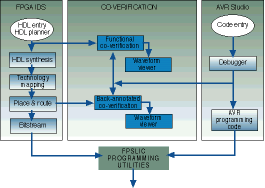

Atmel's field programmable system level integration circuit (FPSLIC) design tool - SystemDesigner, is the industry's first integrated tool suite with co-verification available for creating and implementing programmable system-on-chip (SOC) designs, says the company.
SystemDesigner provides everything necessary to implement SOC designs on the desktop - including Atmel's advanced FPGA timing-driven place and route and AVR microcontroller development and debug tools; Exemplar Synthesis, Model Technology hardware simulator and co-verification powered by Mentor's co-verification tools. Co-verification is an important design tool that enables the hardware simulator for the FPGA HDL code to interact directly with the instruction set simulator of the processor. This enables the hardware and software elements of a system to be designed and verified using a 'virtual prototype' early in the design process - eliminating the need for hardware emulation and multiple PCB redesigns. The co-verification tools are the first offered for programmable logic design - significantly reducing design time, risk and overall cost of system development.
"Atmel's FPSLIC architecture integrates an embedded processor, FPGA and other Intellectual Property cores on a single slice of silicon," states Martin Mason, Atmel's Programmable SLI Marketing Manager. "FPSLIC combines the flexibility of programmable logic with system-level integration while bringing advanced processor technology to the broad marketplace."
"FPSLIC differs from high density FPGAs by implementing the processor, memory and peripherals as hardwired fixed logic (ASIC gates), while the FPGA portion enables customisation and provides the flexibility benefits associated with programmable logic. With FPSLIC and SystemDesigner developers can focus on defining the system functionality, rather than worrying about implementation issues such as whether the processor will fit in the FPGA and run at the correct speed. This results in significantly faster time-to-market, reduced power consumption, lower device cost, higher performance designs and lower design risk." Mason concluded.
"FPSLIC is a platform architecture that supports the implementation of various combinations of 8 bit through 64 bit and higher processors along with different-sized FPGA cores, program and data memory, peripherals and other fixed and custom logic," said Joel Rosenberg, Product Line Director for Programmable System Level Integration. "If the system design requires additional custom logic, those functions can be programmed into the FPGA and, if required, mapped directly into the address space of the embedded processor."
"SystemDesigner is a comprehensive design tool that can support virtually any industry standard processor core available today, as well as industry standard synthesis and simulation tools. This powerful platform enables Atmel to leverage its ASIC, FPGA, Memory and Processor and associated design tool capabilities to bring a family of devices that offer the programmable benefits of FPGA to the system-on-chip marketplace," Rosenberg concluded.
About AT94 FPSLIC
The in-system programmable AT94K FPSLIC family integrates all the major building blocks required for system level design - up to 40 000 gates of Atmel's AT40K (field programmable gate array) with FreeRAM, 30+ MIPS AVR RISC processor, 32 KB of program memory, 4K of data memory frequently used on chip peripherals such as UARTs, timer/counters, an industry standard two-wire serial bus and a hardware multiplier.
Additional peripherals can be created in the FPGA and mapped directly in the address space of the microcontroller. The entire device is SRAM-based, allowing both the instruction set for the microcontroller and the hardware code for the FPGA to be reconfigured in-system, any number of times, either during development, production, or remotely at the end-customer sight.
The benefits of this solution can provide up to 70% board area reduction, 50% lower power consumption, 50% performance improvement and significantly reduced development cycles over discrete and other programmable solutions.
Market research estimates the market for such devices could exceed $40 billion in the next 10 years, potentially dwarfing the existing $5B programmable logic market, claims Atmel.
Atmel SA
082 894 7223
| Tel: | +27 11 923 9600 |
| Email: | info@arrow.altech.co.za |
| www: | www.altronarrow.com |
| Articles: | More information and articles about Altron Arrow |

© Technews Publishing (Pty) Ltd | All Rights Reserved